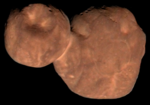 168P/Hergenrother during its 2012 outburst. By Mount Lemmon Observatory. 168P/Hergenrother during its 2012 outburst. By Mount Lemmon Observatory. | |
| Discovery | |
|---|---|
| Discovered by | Carl W. Hergenrother |
| Discovery date | November 22, 1998 |
| Designations | |
| Alternative designations | P/1998 W2 P/2005 N2 |
| Orbital characteristics | |
| Epoch | March 6, 2006 |
| Aphelion | 5.839 AU |
| Perihelion | 1.426 AU |
| Semi-major axis | 3.632 AU |
| Eccentricity | 0.6075 |
| Orbital period | 6.923 a |
| Inclination | 21.8934° |
| Last perihelion | August 5, 2019 October 1, 2012 November 2, 2005 |
| Next perihelion | 2026-May-18 |
| Earth MOID | 0.4 AU (60 million km) |
168P/Hergenrother is a periodic comet in the Solar System. The comet originally named P/1998 W2 returned in 2005 and got the temporary name P/2005 N2. The comet was last observed in January 2020, and may have continued fragmenting after the 2012 outburst.
2012 outburst
The comet came to perihelion on October 1, 2012, and was expected to reach about apparent magnitude 15.2, but due to an outburst the comet reached apparent magnitude 8. As a result of the outburst of gas and dust, the comet was briefly more than 500 times brighter than it would have been without the outburst. On October 19, 2012, images by the Virtual Telescope Project showed a dust cloud trailing the nucleus. Images by the 2 m (79 in) Faulkes Telescope North on October 26, 2012, confirm a fragmentation event. The secondary fragment was about magnitude 17. Further observations by the 8.1 m (320 in) Gemini telescope show that the comet fragmented into at least four parts.
2019
168P came to perihelion on August 5, 2019, when it was 76 degrees from the Sun. It then made a closest approach to Earth on 6 November 6, 2019, when it was 1 AU (150 million km) from Earth with a solar elongation of about 110 degrees. It was not recovered until January 3, 2020, when it was 141 degrees from the Sun, but only two observations on a single night were reported.
References
- ^ "168P/Hergenrother Orbit". Minor Planet Center. Retrieved 2014-06-20.
- Syuichi Nakano (2012-07-17). "168P/Hergenrother (NK 2283)". OAA Computing and Minor Planet Sections. Retrieved 2012-10-13.
- ^ Syuichi Nakano (2009-04-23). "168P/Hergenrother (NK 1778)". OAA Computing and Minor Planet Sections. Retrieved 2012-02-20.
- IAUC 8560: recovery of comet P/1998 W2
- Seiichi Yoshida (2012-02-21). "168P/Hergenrother (2012)". Seiichi Yoshida's Comet Catalog. Retrieved 2012-02-25.
- Math:
- Gianluca Masi (October 19, 2012). "Comet 168P/Hergenrother: hi-res images (19 Oct. 2012)". Virtual Telescope Project. Retrieved 2016-10-18.
- Giovanni Sostero; Nick Howes; Ernesto Guido (October 26, 2012). "Splitting event in comet 168P/Hergenrother". Remanzacco Observatory in Italy – Comets & Neo. Retrieved 2012-10-28.
- Phil Plait (2012-11-05). "Breaking up is easy to do. If you're a comet". Bad Astronomy. Archived from the original on 2012-11-08. Retrieved 2012-11-05.
External links
- 168P on Seiichi Yoshida's comet list
- Elements and Ephemeris for 168P/Hergenrother – Minor Planet Center
- 168P at Kronk's Cometography
- Comet 168P Hergenrother in outburst (Google+ chat archive Oct 12, 2012)
- Comet Hergenrother in Outburst (Carl Hergenrother : 20 Oct 2012)
- Comet 168P and fragment as seen by Kitt Peak WIYN 3.5-metre (140 in) on 30 Oct 2012
- Scientists Monitor Comet Breakup (168P-Hergenrother was imaged by the NOAO/Gemini telescope Nov. 2, 2012)
- Temporal Correlation Between Outbursts and Fragmentation Events of Comet 168P/Hergenrother (arXiv:1409.7641 : 26 Sep 2014)
| 2019 in space | ||
|---|---|---|
| Space probe launches |
|    |
| Impact events |
| |
| Selected NEOs | ||
| Exoplanets |
| |
| Discoveries |
| |
| Comets | ||
| Space exploration |
| |
| Numbered comets | ||
|---|---|---|
| Previous 167P/CINEOS |
168P/Hergenrother | Next 169P/NEAT |


